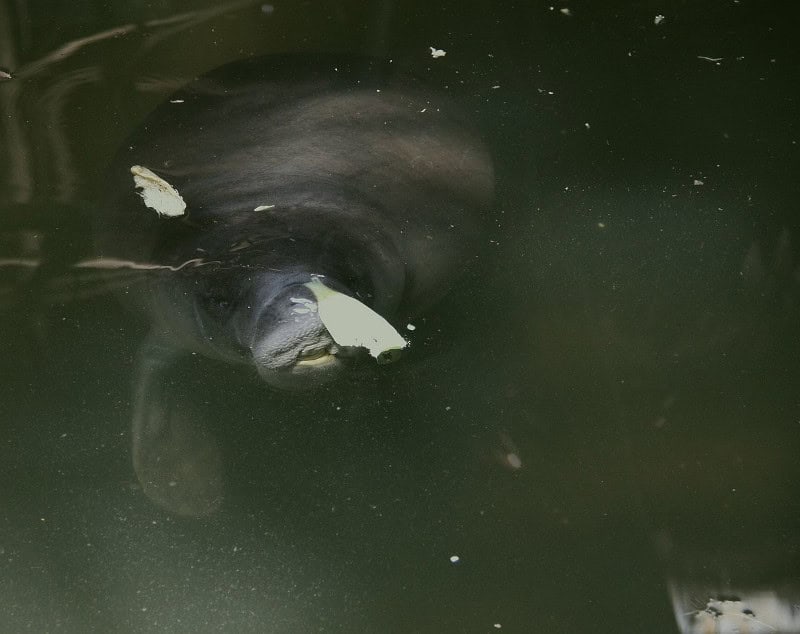
Amazonian Manatee Facts
- This marvel of nature and evolution most frequently goes by the informative common name of the Amazonian Manatee. For the moment, the remarkable mammal has no other widely accepted general name. Though not unknown, that’s uncommon.
- In scientific circles, though, it’s better known by its formal title. That, however, as often remains the case, is a difficult term for the majority of laymen to pronounce. That’s because this wonder of creation bears the technical moniker Trichechus inunguis.
- The impressive creature received that slightly tongue-twisting title due to the efforts of the Australian naturalist, Johann Natterer. He accomplished the first formal acknowledgement of the animal as a separate and distinct species in the year 1883.
- This intriguing sirenian constitutes the only one of the three known species to live entirely in a freshwater habitat. It also distinguishes itself from its kindred in another manner. Physically, it’s the smallest of its relatives. It’s nonetheless a fascinating animal.
- Lamentably, the population base of the Amazonian Manatee appear to be continually diminishing. That regrettable situation further seems to hold true throughout the entirety of its territory. The IUCN, therefore, now lists it as Vulnerable on its Red List.
- It faces multiple threats to its continued existence. In the short term, hunting and habitat loss form its leading perils. It does face another, longer term danger, though. Like most forms of life on earth, it also now faces the looming threat of climate change.
Related Articles
West Indian Manatee
Amazonian Manatee Physical Description
The Amazonian Manatee may be the smallest of its brethren, but it nevertheless impresses those fortunate enough to encounter it. It does so due to its appearance more than size, at least compared to those relatives. It has several physical attributes unique to it.
It does follow some patterns common to its kind, however. Among those is the presence of the physiological characteristic of sexual dimorphism. In its case, this trait manifests itself in terms of pure size. Specifically, females reach slightly greater sizes than males.
Sizes vary significantly, even within the same gender, often due to local environmental factors. Certain statistics hold true, though. Females attain a total maximum body length of roughly 8 ft 9 in (2.67 m). Males, however, only reach a known length of 7 ft 5 in (2.25 m).
Females of the species also attain a greater maximum weight than their male counterparts. They reach up to 836 lb (379 kg) in mass. The marginally smaller males, meanwhile, reach up to 736 lb (346 kg) in weight. Most individuals never grow quite this large, though.
Otherwise, specimens of both genders of the Amazonian Manatee remain virtually identical in outward appearance. The body shape is roughly cyclindrical in form. The forelimbs evolved into flippers. A large, rounded, horizontal paddle appears at the rear of the body.
The animal also has much smoother, rubbery skin than its genetic cousins. It additionally lacks any vestigial nails on its flippers, unlike those same relatives. Its overall color scheme is almost universally gray, except for the presence of a white or pink spot on the breast.
- Kingdom: Animalia
- Phylum: Chordata
- Class: Mammalia
- Order: Sirenia
- Family: Trichechidae
- Genus: Trichechus
- Species: T. inunguis
Amazonian Mantee Distribution, Habitat, and Ecology
The Amazonian Manatee evolved as native to a somewhat limited region of the globe. The exact location of that zone of habitation, however, comes as no surprise. That’s true due to the name of the animal. As that implies, it lives in a specific part of South America.
More specifically, and obviously, that area consists of the Amazon River Basin. That region begins around the Marajó Islands, in the country of Brazil. From there, though, its territory extends through Colombia, Ecuador, and Peru, overlapping that of one of its cousins.
The sirenian, like many such animals, further evolved decidedly strong preferences in its choice of habitat. Unfortunately for it, however, that very trait limits its adaptability. The habitat of this amazing work of Nature also remains reasonably clear, given its name.
As an entirely freshwater-dwelling species, it lives in the waters of the Amazon River. It also ventures into the seasonally flooded regions of surrounding forests on a temporary basis. During periods of above-average flooding, it’s even sometimes seen in inundated fields!
The Amazonian Manatee developed as both nocturnal and diurnal in its patterns of activity. It lives nearly its entire life submerged. Most of the time, only its nostrils appear above the surface of the water. It spends most of its time searching the area for food to consume.
It also feeds entirely herbivorously. The largest portion of its diet by far consists of various locally abundant varieities of aquatic plants. It also feeds opportunistically on fruits that fall into the water. This bulky creature typically consumes about 8% of its body mass per day!
Species Sharing Its Range
Check out our other articles on 7 Magical North American Moths, Axolotl, Deception Island, Philippine sailfin lizard, Genji-botaru, Wheel Flower, Scalloped Hammerhead, Tufted coquette
